Transcend SSD320 & SSD720 (256GB) Review
by Kristian Vättö on January 25, 2013 11:31 AM ESTAnandTech Storage Bench 2011
Last year we introduced our AnandTech Storage Bench, a suite of benchmarks that took traces of real OS/application usage and played them back in a repeatable manner. Anand assembled the traces out of frustration with the majority of what we have today in terms of SSD benchmarks.
Although the AnandTech Storage Bench tests did a good job of characterizing SSD performance, they weren't stressful enough. All of the tests performed less than 10GB of reads/writes and typically involved only 4GB of writes specifically. That's not even enough exceed the spare area on most SSDs. Most canned SSD benchmarks don't even come close to writing a single gigabyte of data, but that doesn't mean that simply writing 4GB is acceptable.
Originally we kept the benchmarks short enough that they wouldn't be a burden to run (~30 minutes) but long enough that they were representative of what a power user might do with their system. Later, however, we created what we refer to as the Mother of All SSD Benchmarks (MOASB). Rather than only writing 4GB of data to the drive, this benchmark writes 106.32GB. This represents the load you'd put on a drive after nearly two weeks of constant usage. And it takes a long time to run.
1) The MOASB, officially called AnandTech Storage Bench 2011—Heavy Workload, mainly focuses on the times when your I/O activity is the highest. There is a lot of downloading and application installing that happens during the course of this test. Our thinking was that it's during application installs, file copies, downloading, and multitasking with all of this that you can really notice performance differences between drives.
2) We tried to cover as many bases as possible with the software incorporated into this test. There's a lot of photo editing in Photoshop, HTML editing in Dreamweaver, web browsing, game playing/level loading (Starcraft II and WoW are both a part of the test), as well as general use stuff (application installing, virus scanning). We included a large amount of email downloading, document creation, and editing as well. To top it all off we even use Visual Studio 2008 to build Chromium during the test.
The test has 2,168,893 read operations and 1,783,447 write operations. The IO breakdown is as follows:
| AnandTech Storage Bench 2011—Heavy Workload IO Breakdown | ||||
| IO Size | % of Total | |||
| 4KB | 28% | |||
| 16KB | 10% | |||
| 32KB | 10% | |||
| 64KB | 4% | |||
Only 42% of all operations are sequential; the rest ranges from pseudo to fully random (with most falling in the pseudo-random category). Average queue depth is 4.625 IOs, with 59% of operations taking place in an IO queue of 1.
Many of you have asked for a better way to really characterize performance. Simply looking at IOPS doesn't really say much. As a result we're going to be presenting Storage Bench 2011 data in a slightly different way. We'll have performance represented as Average MB/s, with higher numbers being better. At the same time we'll be reporting how long the SSD was busy while running this test. These disk busy graphs will show you exactly how much time was shaved off by using a faster drive vs. a slower one during the course of this test. Finally, we will also break out performance into reads, writes, and combined. The reason we do this is to help balance out the fact that this test is unusually write intensive, which can often hide the benefits of a drive with good read performance.
There's also a new light workload for 2011. This is a far more reasonable, typical every day use case benchmark. It has lots of web browsing, photo editing (but with a greater focus on photo consumption), video playback, as well as some application installs and gaming. This test isn't nearly as write intensive as the MOASB but it's still multiple times more write intensive than what we were running last year.
We don't believe that these two benchmarks alone are enough to characterize the performance of a drive, but hopefully along with the rest of our tests they will help provide a better idea. The testbed for Storage Bench 2011 has changed as well. We're now using a Sandy Bridge platform with full 6Gbps support for these tests.
AnandTech Storage Bench 2011—Heavy Workload
We'll start out by looking at average data rate throughout our new heavy workload test:
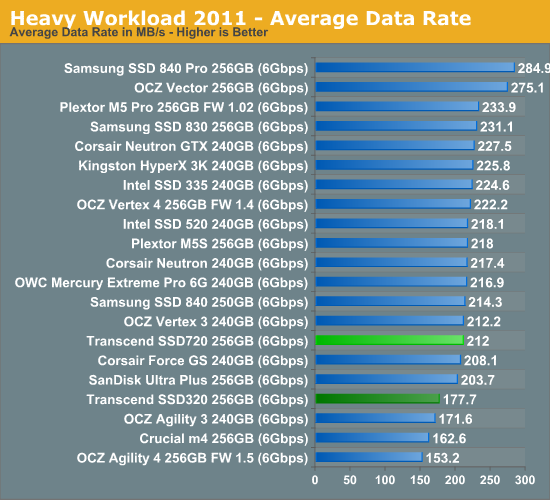
Our Heavy suite pretty much summarizes the results we saw in synthetic tests. The SSD720 is around 20% faster but most of the difference comes from its faster read speed, which is largely due to SSD320's poor read performance with incompressible data.
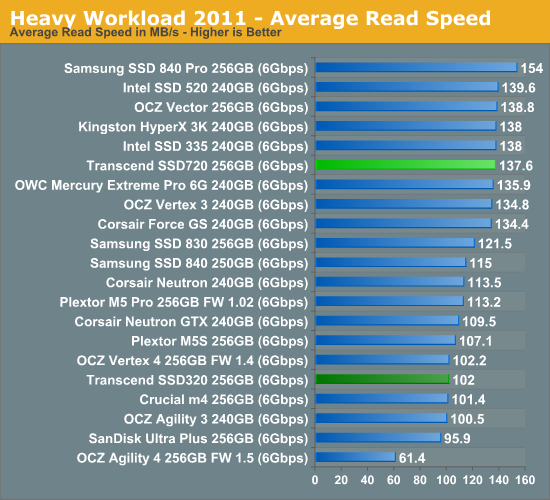

The next three charts just represent the same data, but in a different manner. Instead of looking at average data rate, we're looking at how long the disk was busy for during this entire test. Note that disk busy time excludes any and all idles, this is just how long the SSD was busy doing something:
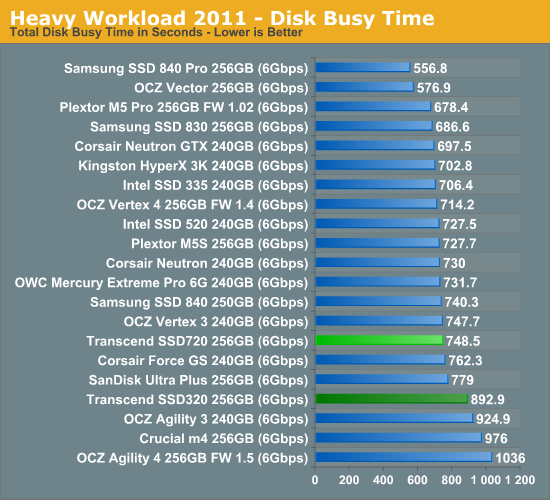
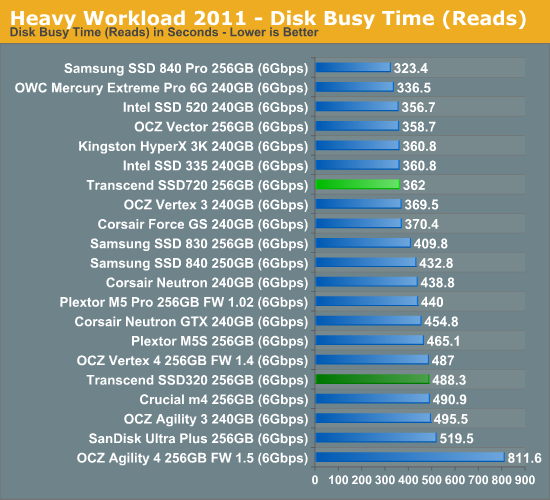
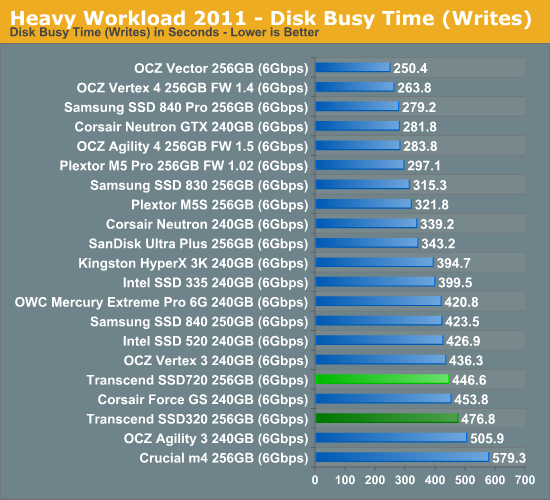










34 Comments
View All Comments
Rick83 - Friday, January 25, 2013 - link
I have two SSDs that were reasonable unique when I got them, both from Transcend, so I am not sure how you can complain about that.One is an IDE Flash module, and the other is a 44pin IDE 2.5"SSD. Both use SLC flash.
They were in the industrial/module market quite early, and quite strongly.
Adding some cheaply implemented Sandforce drives allows them probably to sell more volume, and thus get better pricing on flash. I'm not sure if that is their main market though.
Meanwhile, there is slightly more competition in IDE SSDs, but then that market is also not going to grow very much. Of course there are also SSD and USB modules available, so that's also an interesting niche, where there is a different market situation, than for "mainstream" SSDs.
Finally, I consider the Transcend brand to be relatively strong in the flash memory market, they've been present for quite a while.
Customer support in Europe is also reasonably good.
Kristian Vättö - Friday, January 25, 2013 - link
I'm aware that Transcend has "niche" products that are aimed for very specific uses. What I meant, however, was that their mainstream (mainly 2.5" SATA) lineup is not very special. Like I said, there are probably a dozen manufacturers with similar SandForce SSD lineups.The final part of the article was merely a general observation of the current SSD market, I didn't aim it specifically at Transcend (it's something I've been wanting to say for a while). Transcend does have fairly large presence in Europe (I'm from Finland myself) when it comes to SD cards and USB sticks, but not really in SSDs (then again, SSDs aren't everyday items yet, so that matters too).
Overall I'd just like to see more non-SF SSDs. You can't really gain any major market share with SandForce drives anymore, there are too many competitors.
kmmatney - Friday, January 25, 2013 - link
It is nice that they include a toolbox. I have a few SSDs in Windows XP machines at work, and I like being able to manually TRIM the drive. I buy Samsung and Intel SSDs just for the toolboxes they provide, but this would be a viable option now as well.Kristian Vättö - Saturday, January 26, 2013 - link
Keep in mind that the TRIM or secure erase functions in the toolbox do not work, like I mentioned in the article.Death666Angel - Friday, January 25, 2013 - link
It's really sad that most of these SF based drives aren't even that much cheaper (if at all) compared to the big brand names you mentioned.Samus - Saturday, January 26, 2013 - link
Right. There's no logical reason to buy a sandforce drive when the Samsung 830/840 and Crucial M4 have the same (or lower) price with superior reliability and relatively identical performance.Then there is the 840 Pro which has ridiculous performance and presumably excellent reliability.
Don't get me wrong though, I think the Intel SSD 330/335 is a great value and it is the only Sandforce drive I'd buy. Every OCZ SF drive I, my family, or friends, have ever had, has inexplicably failed.
speculatrix - Saturday, January 26, 2013 - link
Having experienced OCZ technical support when trying to resolve linux driver problems with their Revo cards (ongoing for 3 months with tgem holding onto $1000's of worth of cards) I shall never buy an OCZ product ever again.They fail to communicate or use their own ticketing system effectively, pronounce testing done when it hasn't, and generally all we feel is that our time and money has been wasted.
embzyk - Sunday, January 27, 2013 - link
I see write amplification less than 1.0 a logical reason, and the reason why every SSD I buy is sandforce based. The first one I ever bought died, but its replacement and 7 others are going strong - including 4 from OCZ.twotwotwo - Friday, January 25, 2013 - link
"The client SSD market currently has more manufacturers than it can feed in the long run."If the fixed costs are low enough, it may take the small ones a long time to go away--if everyone pays the sameish rate for NAND, controller licenses, etc., they may be more like PC builders than HDD makers.
If that changed significantly--say, if SandForce and other competitive controllers were bought by certain makers who used them exclusively--that math could change quickly.
hfm - Friday, January 25, 2013 - link
I bought one of the 512GB SSD720 a while back because it was the cheapest 500MB/s 512GB SSD at the time I bought it (paid $399, walked to B&H to get it). I have been extremely happy with it. The Samsung 512GB drive was much more expensive at the time. My primary use case for it is gaming laptop, so I felt the cost increase for a better drive would see a negligible boot/load time increase.Of course I keep it backed up by cloning to a second spinner in the laptop and then again to my nas, so I don't completely trust it's long term reliability. It's been bullet proof and screaming fast so far.